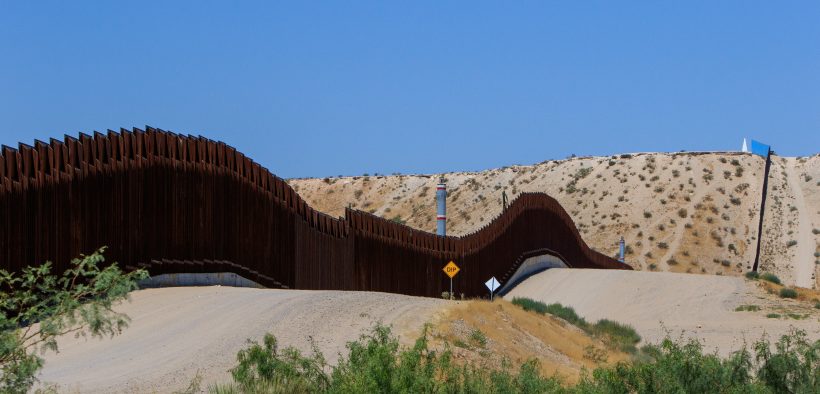Early on the morning of July 8, a woman was found by Border Patrol agents with a severe head injury, just north of the border wall in New Mexico. Scant information is available regarding her identity, and it appears that no law enforcement agency is investigating her death.
Incidents like this — in which no press release disclosed her death, no agency has claimed responsibility for investigating it, and no public identification of the woman has been made — begs the question: how many migrants die and then fall through the cracks of complex bureaucracy, with far-away family members left wondering what happened?
What we know
Our Jane Doe had apparently fallen from the border wall, which stretches to a height of 18 feet at that point along the U.S.-Mexico border, just west of El Paso where Anapra, Mexico, and Sunland Park, New Mexico, meet.
“So, somebody fell from the fence. They’re unresponsive. They are breathing,” said an agent on a dispatch call recording about the incident, provided by Mesilla Valley Regional Dispatch Authority.
U.S. Border Patrol Agents who were assigned to the Santa Teresa Station reported that they found her near the border wall. “The woman’s breathing was labored and she was bleeding from her head,” Border Patrol spokeswoman Valeria Morales said in a statement.
Border Patrol agents immediately called for medical help, with Sunland Park Fire Department and emergency medical technicians arriving at the scene at 6:15 a.m., according to dispatch records. Jane Doe was then rushed to University Medical Center in El Paso, and died shortly after arrival at the trauma bay.
Irene Santiago, chief of operations for the El Paso medical examiner, confirmed that an autopsy was conducted on Jane Doe, but was unable to provide any additional information.
Who has jurisdiction?
Depending on who you ask, you will get many different answers to the question of which law-enforcement agency is responsible for this case. Efforts to determine whether anyone is investigating her death resulted in a never-ending game of pass the flag among local, regional, and federal agencies.

My first email to the Border Patrol suggested that Sunland Park Police Department was the investigating agency. Deputy Chief Eric Lopez of the Sunland Park Police Department then responded to an inquiry about this case saying, “Our department personnel were in fact NEVER on scene, I don’t know why Border Patrol is telling you that we are the investigating agency, that is 100% incorrect.” Lopez then said this incident fell within federal jurisdiction.
But federal agency representatives said they lacked jurisdiction. Frank Fisher of the FBI’s Albuquerque Division said “the FBI does not have a role in these kinds of cases unless there is evidence of a federal crime.”
When I called the Doña Ana Sheriff’s Office, a representative said she didn’t see anything in her notes for that day.
Efforts to determine who would assign jurisdiction in this case were equally murky. I called one of El Paso’s nine justices of the peace, who then said to call the county attorney, who suggested that a federal agency was likely involved. Since Sunland Park, New Mexico doesn’t have a Justice of the Peace, I tried the Sunland Park Municipal Court, which referred me to the Doña Ana County clerk. The county clerk said to talk to the district court clerk, who said to talk to the sheriff.
Each person I called sent me to someone else, who then sent me to someone else, and all of them seemed somewhat confused by how the process should work in this case.
How uncommon can interstate migrant issues be in a community like El Paso? The place where this woman was found is a common border-crossing spot, just outside of El Paso County but within the El Paso Border Patrol sector. I found it baffling that there wasn’t more of a system for handling cases like this, and told many of these phone representatives as much.
I spoke with Stephanie Leutert, a scholar at the University of Texas at Austin who has devoted substantial time to studying migrant deaths in South Texas and recently published an in-depth report on the topic.

“Migrant deaths in Texas, it’s the biggest black hole. It’s so hard to track down, there’s so many (deaths), and then it looks slightly different in every place. It’s complicated, to say the least,” Leutert said.
Someone has a legal obligation to find out more about the circumstances around her death, but who? We know that she was found with a traumatic head injury near the border wall, but we do not know for certain that she fell.
For an investigation to be called off, a death must be ruled accidental, but so far it appears that no agency has done enough investigating even to make that call.
Kate Spradley, professor at Texas State University’s Department of Anthropology, studies identification methods for migrant border crossing fatalities.
“All unidentified deaths or all trauma deaths have to be investigated. And those remains will stay here until they are identified. It’s just sad. It’s sad and it continues. I know in the time of coronavirus, people’s resources and money are elsewhere, but this person has a family too, and they need to know what happened to her,” Spradley said.
“This is a person, this is a person with a family. It’s just the same story over and over again, and it’s horrible.”
How uncommon is this case?
A Border Patrol agent who asked not to be identified because they’re not authorized to speak publicly said that migrants frequently fall from the border wall in the El Paso sector.
“There’s a large number of people that try to enter illegally by jumping the wall, that get major injuries that have to go to the hospital. And those hospital bills are ridiculous,” the agent said.
The Border Patrol reports that there have been eight migrant border-crossing deaths in the El Paso sector so far in 2020, compared to 20 deaths recorded by the Border Patrol in 2019.
Scholars like Spradley and Leutert emphasize that official numbers are typically inaccurate and undercount the frequency of border-crossing fatalities. A 2018 CNN study found that the Border Patrol had failed to count hundreds of migrant deaths in the United States. A situation like Jane Doe’s would not be counted in this tally unless she were identified, because currently there is no publicly available proof of her nationality.
Even in efforts to identify Jane Doe in this case, communications were confusing because another migrant woman had fallen from the wall just two days later on July 10, and broken her leg. In El Paso Matters’ efforts to identify this woman, a consulate representative had confused her with another border migrant injured from the wall fall.
Earlier this year, another woman died falling from the border wall near El Paso. In that case, the migrant was a 19-year-old Guatemalan, and was seven months pregnant. Neither she nor the fetus survived the fall.
What should happen in cases like this?
According to the Border Patrol agent, a standard process is followed by Border Patrol when a migrant dies as a result of attempting to illegally cross the border.
“If someone observes an illegal immigrant dead, they must call the supervisor in shift, the watch commander and then inform it to radio communications. They will call EMS and the fire department and then whoever else needs to know. If it’s in the city limits they’ll call the police department, and then the police department will get in touch with the coroner. That’s how a death should be handled.”
In this case, because the woman was still alive when the Border Patrol found her, the situation becomes a little more complicated. The Border Patrol fulfilled its obligation by promptly calling for medical help. It is no longer the Border Patrol’s responsibility to call law enforcement, since she was still alive when she left their custody and was taken to the hospital. So whose responsibility is it?

“I think a lot of people don’t understand death investigations for unidentified deaths, so that’s a major problem in those remains not getting to where they need to go, and not being able to track those remains, and then not filling out the appropriate paperwork and DNA samples that could lead to an identification,” Spradley said.
It’s easier for people to get lost in the system when the case involves multiple counties, she said.
Eddie Canales, director of the South Texas Human Rights Center, agreed that this is a common issue. “The lack of investigation in terms of migrant deaths is a major problem that exists,” he said.
“If the person has identification and it’s a fresh body, then they’re able to be fingerprinted, pictures taken, and there’s an effort to reach out to family. If there’s no identification on the person then you’ve got to go through a process. There’s three ways: fingerprints, dental records, and DNA,” said Canales, describing how the identification process should be handled.
With the July 8 Jane Doe, we know that an autopsy has been conducted, but it is unknown what extent of efforts have been taken to identify her, notify her family, and determine the cause of her death. The medical examiner said the autopsy couldn’t be made public until family has been notified.
This case appears to be an example of the black hole described by Leutert. Perhaps more information will be released by law enforcement officials regarding her death and identity, but Leutert says that in the absence of heightened institutional standards for accountability, these answers often don’t come easily.
“It can be hard to know to what extent they are holding people accountable. And from the outside it seems that they are not at all, or very little,” Leutert said. “Maybe internally that’s slightly different. I kind of doubt it, but maybe. If I give them the most benefit of the doubt, except we would never know because it’s not transparent.”
Cover photo: A woman was found mortally injured July 8 at the base of the border wall at the end of Anapra Road near Sunland Park, N.M., (Corrie Boudreaux/El Paso Matters)
This article first appeared on El Paso Matters and is republished here under a Creative Commons license.” data-src=”https://elpasomatters.org/?republication-pixel=true&post=5525&ga=UA-158587614-1″ />


